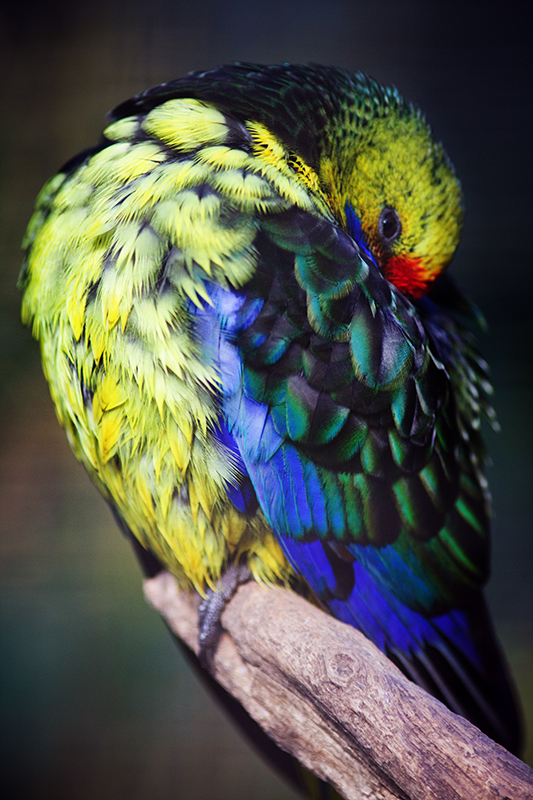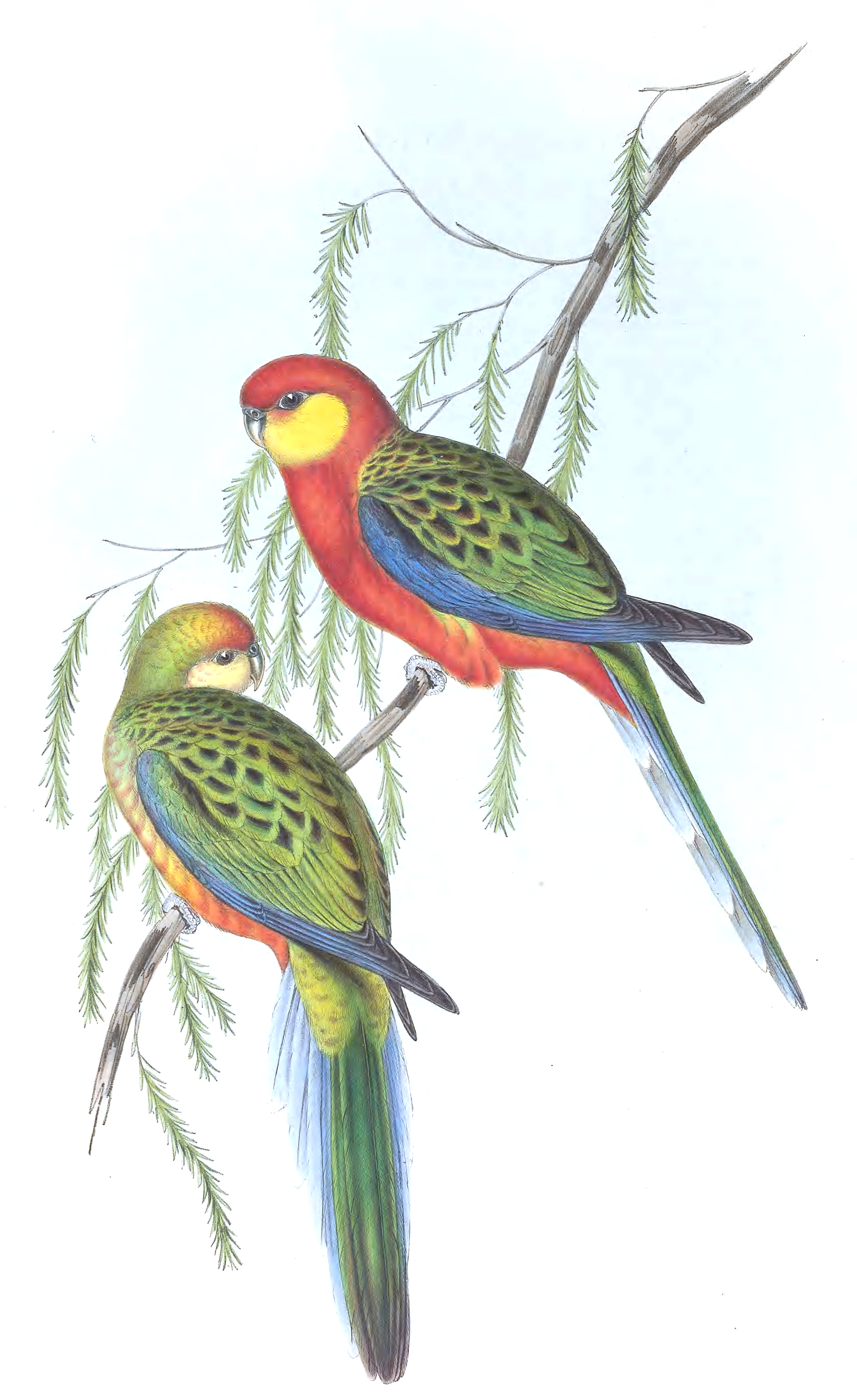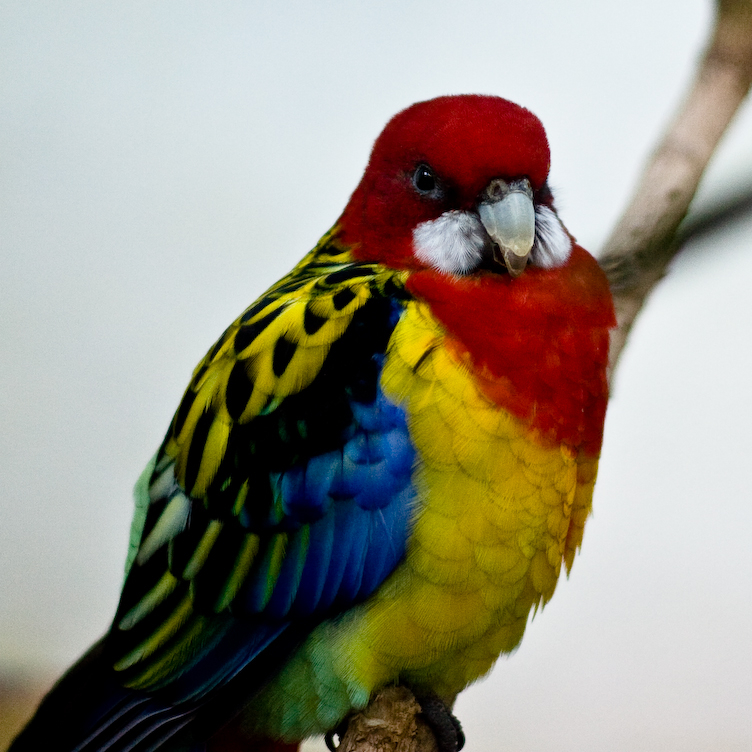|
Rosella
Rosellas are in a genus that consists of six species and nineteen subspecies. These colourful parrots from Australia are in the genus ''Platycercus''. ''Platycercus'' means "broad-tailed" or "flat-tailed", reflecting a feature common to the rosellas and other members of the broad-tailed parrot tribe. Their diet is mainly seeds and fruit. Taxonomy The genus was described by naturalist Nicholas Aylward Vigors in 1825; the name ''Platycercus'' derived from the Greek ''platykerkos'' meaning "broad-" or "flat-tailed", from ''platys'' "broad, wide, level, flat" and ''kerkos'' "tail of a beast"., , . The relationships with other parrots have been unclear, with the Australian ringneck (genus '' Barnardius'') cited as a closest relative by some, and the genus '' Psephotus'' by others; the plumage of the western rosella seen as a link to the latter genus. Early European settlers encountered the eastern rosella at Rose Hill, New South Wales, now Parramatta, and so they called it the ... [...More Info...] [...Related Items...] OR: [Wikipedia] [Google] [Baidu] |
Crimson Rosella
The crimson rosella (''Platycercus elegans'') is a parrot native to eastern and south eastern Australia which has been introduced to New Zealand and Norfolk Island. It is commonly found in, but not restricted to, mountain forests and gardens. The species as it now stands has subsumed two former separate species, the yellow rosella and the Adelaide rosella. Molecular studies show one of the three red-coloured races, ''P. e. nigrescens'', is genetically more distinct. Taxonomy The crimson rosella was described by Johann Friedrich Gmelin in the 13th edition of ''Systema Naturae'' in 1788 as ''Psittacus elegans''. The binomial name had been used by Clusius to describe the hawk-headed parrot in 1605, however this predates the start of Linnean taxonomy. The crimson rosella had been described and named by John Latham in 1781 as the "Beautiful Lory", from a specimen in the collection of Sir Joseph Banks, and then as the "Pennantian Parrot" in 1787 in honour of Thomas Pennant. Howeve ... [...More Info...] [...Related Items...] OR: [Wikipedia] [Google] [Baidu] |
Crimson Rosella
The crimson rosella (''Platycercus elegans'') is a parrot native to eastern and south eastern Australia which has been introduced to New Zealand and Norfolk Island. It is commonly found in, but not restricted to, mountain forests and gardens. The species as it now stands has subsumed two former separate species, the yellow rosella and the Adelaide rosella. Molecular studies show one of the three red-coloured races, ''P. e. nigrescens'', is genetically more distinct. Taxonomy The crimson rosella was described by Johann Friedrich Gmelin in the 13th edition of ''Systema Naturae'' in 1788 as ''Psittacus elegans''. The binomial name had been used by Clusius to describe the hawk-headed parrot in 1605, however this predates the start of Linnean taxonomy. The crimson rosella had been described and named by John Latham in 1781 as the "Beautiful Lory", from a specimen in the collection of Sir Joseph Banks, and then as the "Pennantian Parrot" in 1787 in honour of Thomas Pennant. Howeve ... [...More Info...] [...Related Items...] OR: [Wikipedia] [Google] [Baidu] |
Platycercus Elegans
The crimson rosella (''Platycercus elegans'') is a parrot native to eastern and south eastern Australia which has been introduced to New Zealand and Norfolk Island. It is commonly found in, but not restricted to, mountain forests and gardens. The species as it now stands has subsumed two former separate species, the yellow rosella and the Adelaide rosella. Molecular studies show one of the three red-coloured races, ''P. e. nigrescens'', is genetically more distinct. Taxonomy The crimson rosella was described by Johann Friedrich Gmelin in the 13th edition of '' Systema Naturae'' in 1788 as ''Psittacus elegans''. The binomial name had been used by Clusius to describe the hawk-headed parrot in 1605, however this predates the start of Linnean taxonomy. The crimson rosella had been described and named by John Latham in 1781 as the "Beautiful Lory", from a specimen in the collection of Sir Joseph Banks, and then as the "Pennantian Parrot" in 1787 in honour of Thomas Pennant. H ... [...More Info...] [...Related Items...] OR: [Wikipedia] [Google] [Baidu] |
Platycercus Caledonicus
The green rosella or Tasmanian rosella (''Platycercus caledonicus'') is a species of parrot native to Tasmania and Bass Strait islands. It was described by the German naturalist Johann Friedrich Gmelin in 1788, and named on the mistaken assumption it came from New Caledonia. At long it is the largest species of the rosella genus, ''Platycercus''. Two subspecies are recognised. The green rosella's underparts, neck and head are yellow, with a red band above the beak and violet-blue cheeks. The back is mostly black and green, and its long tail blue and green. The sexes have similar plumage, except the female has duller yellow plumage and more prominent red markings, as well as a smaller beak. Juvenile and immature birds have predominantly green plumage. Found in a wide range of habitats with some form of tree cover, the green rosella is predominantly herbivorous, consuming seeds, berries, nuts and fruit, as well as flowers, but may also eat insect larvae and insects such as ... [...More Info...] [...Related Items...] OR: [Wikipedia] [Google] [Baidu] |
Green Rosella
The green rosella or Tasmanian rosella (''Platycercus caledonicus'') is a species of parrot native to Tasmania and Bass Strait islands. It was species description, described by the German naturalist Johann Friedrich Gmelin in 1788, and named on the mistaken assumption it came from New Caledonia. At long it is the largest species of the rosella genus, ''Platycercus''. Two subspecies are recognised. The green rosella's underparts, neck and head are yellow, with a red band above the beak and violet-blue cheeks. The back is mostly black and green, and its long tail blue and green. The sexes have similar plumage, except the female has duller yellow plumage and more prominent red markings, as well as a smaller beak. Juvenile and immature birds have predominantly green plumage. Found in a wide range of habitats with some form of tree cover, the green rosella is predominantly herbivorous, consuming seeds, berries, nuts and fruit, as well as flowers, but may also eat insect larvae and ... [...More Info...] [...Related Items...] OR: [Wikipedia] [Google] [Baidu] |
Northern Rosella
The northern rosella (''Platycercus venustus''), formerly known as Brown's rosella or the smutty rosella, is a species of parrot native to northern Australia, ranging from the Gulf of Carpentaria and Arnhem Land to the Kimberley (Western Australia), Kimberley. It was described by Heinrich Kuhl in 1820, and two subspecies are recognised. The species is unusually coloured for a rosella, with a dark head and neck with pale cheeks—predominantly white in the subspecies from the Northern Territory and blue in the Western Australian subspecies ''hillii''. The northern rosella's Bird#Anatomy and physiology, mantle and List of terms used in bird topography, scapulars are black with fine yellow scallops, while its back, rump and underparts are pale yellow with fine black scallops. The long tail is blue-green, and the wings are black and blue-violet. Sexual dimorphism, The sexes have similar plumage, while females and younger birds are generally duller with occasional spots of red. Found ... [...More Info...] [...Related Items...] OR: [Wikipedia] [Google] [Baidu] |
Platycercus Venustus
The northern rosella (''Platycercus venustus''), formerly known as Brown's rosella or the smutty rosella, is a species of parrot native to northern Australia, ranging from the Gulf of Carpentaria and Arnhem Land to the Kimberley. It was described by Heinrich Kuhl in 1820, and two subspecies are recognised. The species is unusually coloured for a rosella, with a dark head and neck with pale cheeks—predominantly white in the subspecies from the Northern Territory and blue in the Western Australian subspecies ''hillii''. The northern rosella's mantle and scapulars are black with fine yellow scallops, while its back, rump and underparts are pale yellow with fine black scallops. The long tail is blue-green, and the wings are black and blue-violet. The sexes have similar plumage, while females and younger birds are generally duller with occasional spots of red. Found in woodland and open savanna country, the northern rosella is predominantly herbivorous, consuming seeds, particular ... [...More Info...] [...Related Items...] OR: [Wikipedia] [Google] [Baidu] |
Western Rosella (Platycercus Icterotis)-5-4c
The western rosella (''Platycercus icterotis''), or moyadong, is a species of parrot endemic to southwestern Australia. The head and underparts are bright red, and the back is mottled black; a yellow patch at the cheek distinguishes it from others of the genus '' Platycercus''. Adults of the species exhibit sexual dimorphism with the females duller overall; juveniles lack the striking colours of mature birds and the characteristic patterning is not as easily distinguished. Their communication call is a softly delivered ''pink-pink'' sound, and much of their behaviour is comparatively unobtrusive. Their habitat is in eucalypt forests and woodlands, where they often remain unobserved until they appear to feed on seeds at nearby cleared areas. Individuals form mating pairs and generally remain in one locality, although they will venture out to join small groups at plentiful sources of food. The western rosella is predominantly herbivorous, its diet consisting mostly of seeds of gra ... [...More Info...] [...Related Items...] OR: [Wikipedia] [Google] [Baidu] |
Platycercus Icterotis
The western rosella (''Platycercus icterotis''), or moyadong, is a species of parrot endemic to southwestern Australia. The head and underparts are bright red, and the back is mottled black; a yellow patch at the cheek distinguishes it from others of the genus '' Platycercus''. Adults of the species exhibit sexual dimorphism with the females duller overall; juveniles lack the striking colours of mature birds and the characteristic patterning is not as easily distinguished. Their communication call is a softly delivered ''pink-pink'' sound, and much of their behaviour is comparatively unobtrusive. Their habitat is in eucalypt forests and woodlands, where they often remain unobserved until they appear to feed on seeds at nearby cleared areas. Individuals form mating pairs and generally remain in one locality, although they will venture out to join small groups at plentiful sources of food. The western rosella is predominantly herbivorous, its diet consisting mostly of seeds of gra ... [...More Info...] [...Related Items...] OR: [Wikipedia] [Google] [Baidu] |
Western Rosella
The western rosella (''Platycercus icterotis''), or moyadong, is a species of parrot endemic to southwestern Australia. The head and underparts are bright red, and the back is mottled black; a yellow patch at the cheek distinguishes it from others of the genus '' Platycercus''. Adults of the species exhibit sexual dimorphism with the females duller overall; juveniles lack the striking colours of mature birds and the characteristic patterning is not as easily distinguished. Their communication call is a softly delivered ''pink-pink'' sound, and much of their behaviour is comparatively unobtrusive. Their habitat is in eucalypt forests and woodlands, where they often remain unobserved until they appear to feed on seeds at nearby cleared areas. Individuals form mating pairs and generally remain in one locality, although they will venture out to join small groups at plentiful sources of food. The western rosella is predominantly herbivorous, its diet consisting mostly of seeds of gra ... [...More Info...] [...Related Items...] OR: [Wikipedia] [Google] [Baidu] |
Eastern Rosella
The eastern rosella (''Platycercus eximius'') is a rosella native to southeastern Australia and Tasmania. It has been introduced to New Zealand where feral populations are found in the North Island (notably in the northern half of the island, Taranaki, Waikato and in the Hutt Valley) and in the hills around Dunedin in the South Island. Taxonomy The eastern rosella was named by George Shaw in 1792. It is sometimes considered a subspecies of the pale-headed rosella (''P. adscitus''). The term 'white-cheeked rosella' has been used for a species or superspecies combining the pale-headed and eastern forms. Hybrids of the two taxa have been recorded where their ranges meet in northeastern New South Wales and southeastern Queensland. However, a mitochondrial study published in 2017 found that the eastern rosella was the earlier offshoot of the lineage that split into the pale-headed and northern rosellas, and that nonsister taxa were hence able to hybridise. Three subspecies of east ... [...More Info...] [...Related Items...] OR: [Wikipedia] [Google] [Baidu] |
Platycercus Eximius
The eastern rosella (''Platycercus eximius'') is a rosella native to southeastern Australia and Tasmania. It has been introduced to New Zealand where feral populations are found in the North Island (notably in the northern half of the island, Taranaki, Waikato and in the Hutt Valley) and in the hills around Dunedin in the South Island. Taxonomy The eastern rosella was named by George Shaw in 1792. It is sometimes considered a subspecies of the pale-headed rosella (''P. adscitus''). The term 'white-cheeked rosella' has been used for a species or superspecies combining the pale-headed and eastern forms. Hybrids of the two taxa have been recorded where their ranges meet in northeastern New South Wales and southeastern Queensland. However, a mitochondrial study published in 2017 found that the eastern rosella was the earlier offshoot of the lineage that split into the pale-headed and northern rosellas, and that nonsister taxa were hence able to hybridise. Three subspecies of ea ... [...More Info...] [...Related Items...] OR: [Wikipedia] [Google] [Baidu] |












.jpg)